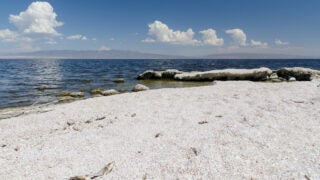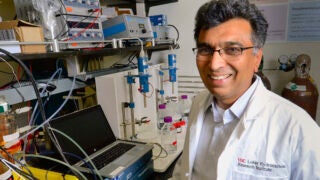
Hot geothermal brine beneath the Salton Sea lake bed and surrounding areas has been identified as a rich source of lithium, a key mineral for making lithium-ion batteries used to power smartphones and electric vehicles and store solar-generated energy. (Illustration/Edel Gonzalez)
Powering Up Lithium Valley
Southern California’s Imperial Valley is a region of economic distress and environmental trauma. Can untapped lithium reserves near the Salton Sea fuel a clean-energy economy — and a more prosperous future?
Chapter 1: Cultivating hope
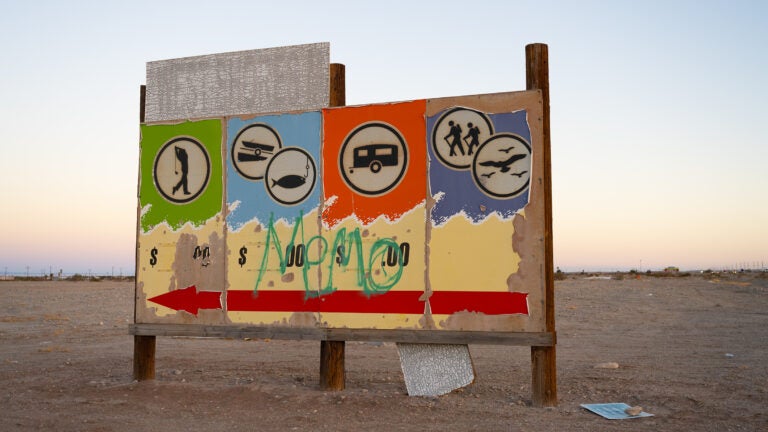
Near the southwest shore of the Salton Sea, a billboard greets visitors. Its brightly colored banners depict an array of activities: golf, boating, fishing, camping and nature trails. A large red arrow pointed toward the lake suggests these recreational opportunities are available nearby. Yet the billboard is tattered: fading, peeling and tagged with graffiti.
The signage is an emblem of the former resort destination’s decline. In the 1950s and ’60s, vacationers flocked to the Golden State’s largest lake for water sports, outdoor recreation and entertainment by the likes of Frank Sinatra and the Beach Boys.
Today, the sea is shrinking, exposing areas of dusty lake bed, or playa, at its edges. The shoreline is crowded not with sunbathers but with thousands of hay bales — part of a strategy to reduce windblown dust from the playa that sickens nearby residents.
Fish bones and barnacle shells crunch underfoot. The sea’s increasing salinity and toxic runoff from the region’s agricultural industry have devastated marine life and made the water unsafe for human recreation. On hot, humid days, when the sea releases hydrogen sulfide gas, a “rotten egg” stink permeates the air.
In towns adjacent to the sea, where a resort “riviera” was once envisioned, run-down mobile home communities are signs of profound economic despair among the predominantly Latino community. Poverty and unemployment rates in the area exceed state averages. Opportunities beyond low-wage, seasonal work at local farms — which supply up to two-thirds of the United States’ winter fruits and vegetables — are few.
Yet approximately a mile below the surface of the Salton Sea’s south shore area lies a resource so sought-after that it has the potential to radically transform the area’s fortunes, the sea’s health — and the country’s electric future.
White gold
Hot geothermal brine beneath the lake bed and surrounding areas has been identified as a rich source of lithium, a key mineral for making lithium-ion batteries used to power smartphones and electric vehicles and store solar-generated energy.
“We’re moving from a fossil fuel-dependent economy to a mineral-dependent economy in which the materials that are used to make batteries are more important than ever,” says Manuel Pastor, Distinguished Professor of Sociology and American Studies and Ethnicity at the USC Dornsife College of Letters, Arts and Sciences and director of the USC Equity Research Institute. “In the Salton Sea’s geothermal brine, there’s enough lithium to redo the entire American auto fleet to electric and still have 100 million batteries left over.”
Pastor is one of several USC researchers who have trained their eyes on the region to study the problems of the past and present and the possibilities of the future. Their research, in many cases done in concert with community leaders, is helping to create a vision for an inclusive and sustainable new lithium economy — one that nurtures the growth of a profitable industry while benefiting local communities and protecting fragile ecologies.
The Imperial Valley’s sizable lithium reserves have attracted several companies racing to become the first to develop a viable, scalable method for extracting the white mineral from the brine. This “white gold” rush has bestowed the area with a new nickname: Lithium Valley.
Hopes are high that the emerging lithium industry will become profitable, infuse the local economy with high-quality jobs and generate tax revenue to fund the restoration of the Salton Sea. But these outcomes are far from assured — particularly in a region that has been vulnerable to economic and environmental exploitation by industrial interests for decades.
“The microcosm of the Salton Sea region helps you get at the question, ‘What does it really mean to move to a clean energy economy?’” says Pastor, who co-authored the recent book Charging Forward: Lithium Valley, Electric Vehicles, and a Just Future with Chris Benner, professor of environmental studies and sociology at the University of California, Santa Cruz. “Who will benefit from the boom — and who will face continued marginalization?”
In the Salton Sea’s geothermal brine, there’s enough lithium to redo the entire American auto fleet to electric and still have 100 million batteries left over.
— Manuel Pastor, Distinguished Professor of Sociology and American Studies and Ethnicity at the USC Dornsife College of Letters, Arts and Sciences
Chapter 2: Getting down to business
Lithium Valley is one of several regions in the United States — including the Smackover Formation in Arkansas and Thacker Pass in Nevada — whose lithium stores have the potential to fortify the country’s clean energy independence. Australia, Chile and China currently rank among the world’s biggest lithium suppliers. Greys Sošić, professor of data sciences and operations at the USC Marshall School of Business, notes that supply chain issues and lithium price spikes during the COVID-19 pandemic highlighted the risks of relying on foreign sources.
“We really need to get a robust and secure domestic industrial base for lithium production,” says Greys Sošić, whose research falls at the intersection of sustainability and supply chain management.
Direct lithium extraction (DLE), the mining method being developed at the Salton Sea, promises to be the world’s most environmentally sustainable method for obtaining lithium. Hot brines from beneath the sea are already being brought to the surface at geothermal energy plants where the steam turns turbines to generate electricity.
“DLE has the potential to be a closed loop because once you bring up the brine, you separate the lithium,” Pastor says. “You can use the heat to power the electricity for the processes and then reinject the brine back into the ground.”
In Australia, lithium is extracted from rock sediments, while in Chile and Argentina, it is isolated by pumping brine from salt flats into evaporation ponds. Compared to these other methods, DLE “requires less energy, less water and less environmental impact,” Sošić says.
For Lithium Valley to become a major player in the emerging domestic base, it must assert its viability quickly. “The Salton Sea is in a bit of a speed campaign to become the first source of domestic lithium,” Pastor says. “If you are early, you can lock in contracts [with battery producers] and set up secure supply chains.”
Shon Hiatt, associate professor of management and organization at USC Marshall and director of USC Marshall’s Business of Energy Transition Initiative, describes Lithium Valley as the underdog among the competing U.S. regions. “The Smackover region of Arkansas is where I believe we’re going to extract the most lithium,” Hiatt says.
“It’s extremely fast to get permits to develop and to build in Arkansas compared to California,” he says, noting California’s complex permitting processes and environmental regulations. Companies have been extracting the chemical element bromine from the Smackover’s aquifer since the 1950s, providing well-established infrastructure for the development of DLE. These factors have attracted legacy energy companies including Exxon Mobil Corp. and Chevron Corp., who are investing in lithium-extraction efforts there.
While global demand for lithium is projected to increase from 2020 levels by 500% by 2050, it has softened in the short term, causing prices for the mineral to plunge over 85% in the past two years. That means companies must race to develop extraction technologies while playing the long game when it comes to profitability.
According to Hiatt, energy giants like Exxon Mobil and Chevron may be better positioned to run a deficit on their lithium investments than the relatively smaller companies investing in the Salton Sea, which include Controlled Thermal Resources Holdings Inc., EnergySource Minerals and BHE Renewables (a subsidiary of Berkshire Hathaway Energy Co.).
“The success of Lithium Valley depends on whether these companies can scale up their technologies to the point where lithium extraction can become profitable,” Hiatt says.
Kicking up dust
The need for speed has led Imperial County officials to streamline California’s typically lengthy environmental review processes for new construction. Rather than evaluate ecological impact on a project-by-project basis, the county adopted a Programmatic Environmental Impact Report (PEIR) that covers all lithium and geothermal projects within a specific geographic area — exempting individual projects from further scrutiny.
But many community activists and researchers are concerned that easing the path for the lithium industry’s growth may come at the expense of protecting public health. The region — a desert dependent on imported water for its agricultural output — is already beset by environmental health hazards: extreme heat waves, agricultural pesticides and air pollution from industrial activity, diesel truck traffic and dust storms.
Even as the Salton Sea has been described as the worst environmental disaster in California’s history, the valley’s stark landscape has a fascinating ecological history. Here, the desert bloomed to feed the nation, and a mighty sea was spawned from an engineering mishap. In 1905, Colorado River floodwater breached an irrigation canal under construction in the valley, forming the Salton Sea. Water levels stayed mostly stable until the late 1990s.
Since then, warming temperatures have increased evaporation from the lake, while more efficient agricultural irrigation and reductions in the county’s allocation of Colorado River water have reduced inflows. As the sea shrinks and dusty lake bed is increasingly exposed, the valley’s fierce dust storms have intensified.
Jill Johnston, associate professor of population and public health sciences at the Keck School of Medicine of USC and spatial sciences at USC Dornsife, has partnered with the Imperial Valley environmental justice group Comite Civico del Valle (CCV) on air quality education and research for more than a decade. She describes dust from the playa as “a toxic soup.”
“The Salton Sea was really a sink for all the agricultural runoff in this region,” says Johnston, naming DDT, arsenic and PCBs as some of the harmful substances from fertilizers and pesticides that have collected in the sediment. “When this dust gets mobilized, not only could you be breathing in the dust, but you could be breathing in some of these chemicals that are also very bad for your health.”
In 2017, Johnston and Shohreh Farzan, associate professor of population and public health sciences at Keck School of Medicine, joined forces with CCV and five local elementary schools to research the impact of dust on children’s respiratory health over time. Their study — published in October 2024 and co-authored by several leaders of CCV — found that dust from the sea triggers asthma, coughing, wheezing and disrupted sleep in children living nearby.
The closer a child’s home is to the sea, the more likely they are to develop wheezing and bronchitis symptoms. Twenty-four percent of children in the area have asthma — far higher than the national rate of 8.4% for boys and 5.5% for girls.
Johnston voices concern that the construction of new lithium-extraction facilities on the fast-drying edges of the sea may exacerbate community health risks.
“Construction activities can displace and mobilize some of the playa,” Johnston says — effectively sending more dust into the air. “Extraction activities can generate a lot of waste, both hazardous waste and wastewater. That potentially could be another way communities get exposed to some of these contaminants.”
Such hazards, combined with a likely increase in truck traffic to serve the growing industry, highlight a contradiction that lies at the heart of Lithium Valley development. While lithium will help accelerate the nation’s transition to green transportation, the extractive industry may worsen air and water quality for local communities.
Last year, these concerns prompted CCV and Earthworks, a national environmental advocacy organization, to sue Imperial County for additional mitigation measures related to lithium-extraction projects by Controlled Thermal Resources to reduce community impacts. CCV and Earthworks alleged that a 7,000-acre lithium and geothermal power campus proposed by the company at a site dubbed “Hell’s Kitchen” had not been adequately studied for its potential impact on air quality and the local fresh water supply.
In January, an Imperial County judge ruled in the county’s favor, arguing further study is not needed and clearing the way for Hell’s Kitchen construction to begin within months after a year of delays.
“This ruling allows us to continue our work to transform Imperial County into a hub of clean energy innovation and sustainable economic growth,” Board of Supervisors Chairman John Hawk told the Desert Sun newspaper at the time of the decision.
Pastor acknowledges the difficulty inherent in balancing community needs with industry imperatives. “Trust takes time,” he says. “Markets move fast.”
The success of Lithium Valley depends on whether these companies can scale up their technologies to the point where lithium extraction can become profitable.
—Shon Hiatt, associate professor of management and organization at USC Marshall
Chapter 3: Jobs of the electric future
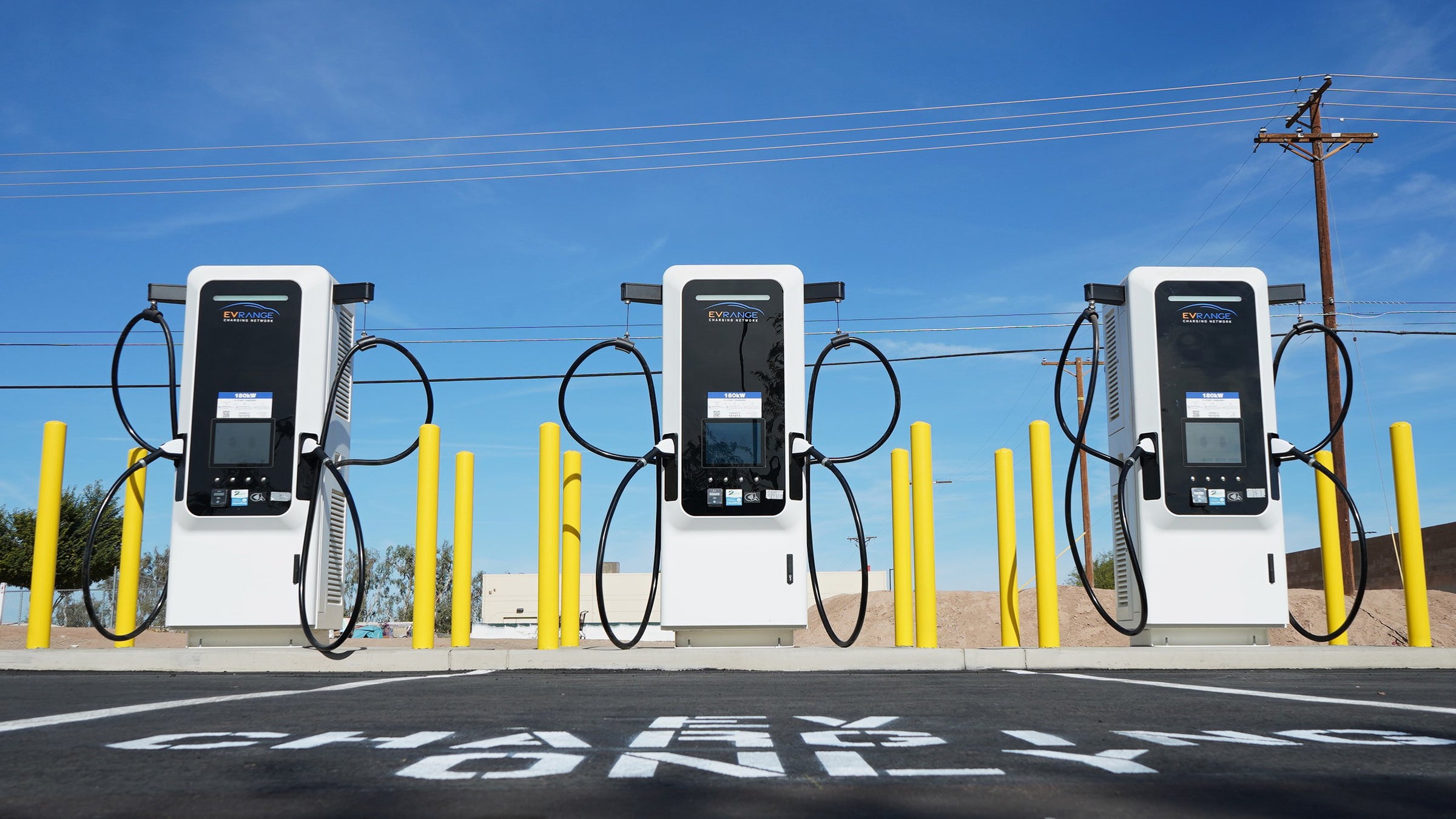
For the impoverished communities surrounding the sea, Lithium Valley holds the promise of an employment boom. At Imperial Valley College, a workforce education certificate program is already preparing community members for lithium-related jobs, including mineral extraction plant operators and chemical lab technicians.
“Lithium companies have promised very high local employment goals,” Pastor says.
Yet Pastor is skeptical of Lithium Valley’s ability to meaningfully shift community employment prospects. A long line of industries — including geothermal, solar and wind power — have come through the valley promising to create sweeping change in the area’s prosperity.
“This is a place of schemes, scams and scoundrels,” says Pastor, noting the region’s history of get-rich swindles involving everything from agriculture and water to real estate and tourism. “In the community, there’s a sense of broken promises, of being left behind, of being ignored — and that makes it very hard for people to find routes to collaboration [with industry] because of a level of distrust,” Pastor says.
In the early 2010s, when the county approved the construction of large solar farms, many local workers became certified solar installers, anticipating an influx of new jobs. Instead, employers only needed a handful of highly skilled workers for long-term work maintaining the solar farms. Most opportunities were temporary construction jobs, and agricultural jobs were displaced by solar projects built on former farmland.
A similar dynamic may play out in the lithium-extraction industry. Sošić notes that significant job creation will happen only if Lithium Valley gives rise to a larger industrial ecosystem — one that includes lithium processing, cell component manufacturing, battery cell production and battery recycling. “Incorporating all these things can hopefully bring new life into the area,” she says.
In 2023, Statevolt, a battery manufacturing startup, acquired land to build a “gigafactory” in Lithium Valley. But the company’s previous efforts to create such factories in the United Kingdom and Italy have been unsuccessful, casting uncertainty on the California project.
Hiatt doubts that the Imperial Valley will be able to develop its lithium industry beyond mere extraction. “What would likely happen is they would ship the extracted lithium to Nevada and process it there, because there are already battery plants in Nevada,” says Hiatt, noting that Nevada, like Arkansas, is a more business-friendly state than California.
Paying community dividends
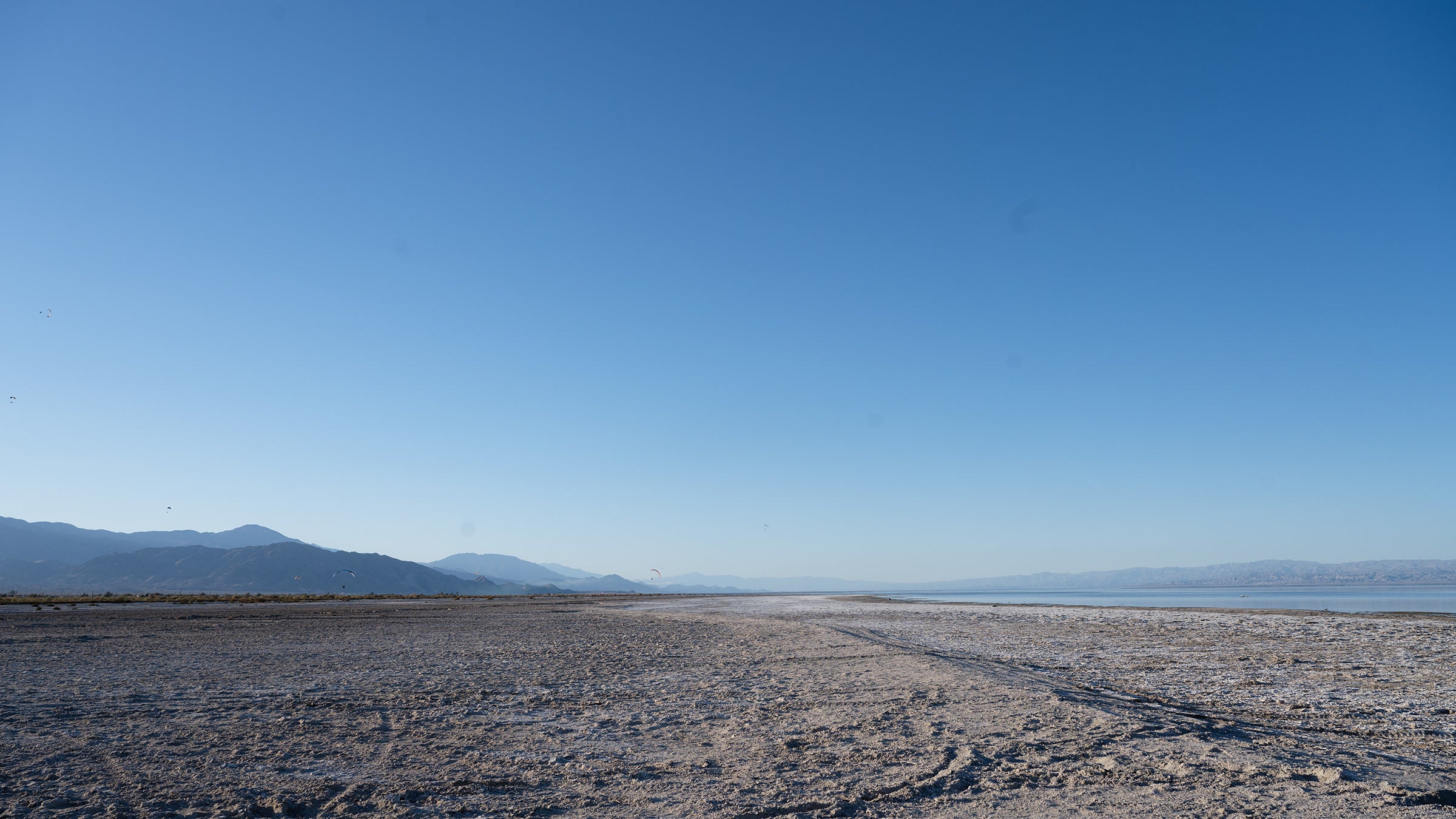
Pastor, echoing a growing chorus of community voices, argues that communities surrounding the sea deserve to reap financial benefits from lithium extraction that extend beyond job creation.
“Lithium has value not just because of companies, but because of public will,” says Pastor, noting taxpayer investments in the green energy transition, with more than $137 million in public subsidies already allocated to lithium companies. “How does the public insist on a return?”
Local groups have vigorously advocated for community benefits agreements from Lithium Valley companies. One victory has been the passage of a county excise tax on lithium extraction based on the volume of lithium mined. Not less than 30% of these future funds are designated to communities affected by extraction activities.
Twenty percent of the revenue is earmarked for the Salton Sea Restoration Fund, a program administered by the California Department of Fish and Wildlife. Rehabilitating the sea, creating wetland wildlife habitat and restoring plant vegetation would help suppress dust and supply much-needed outdoor recreation areas for the community. “The sea should be used as an asset for folks that live there,” Johnston says.
Pastor hopes Lithium Valley will take community compensation one step further by including direct payments to residents. He points to the Alaska Permanent Fund, which distributes oil extraction revenue, as a model. “If you’re a resident of Alaska, you get a dividend each year,” Pastor says. “We’re hoping that this idea is considered as one alternative for the Imperial Valley.”
For Luis Olmedo, executive director of CCV, the current moment presents an opportunity for Lithium Valley to become a world leader in “developing an industry that is safe, that is investing in community through community benefits agreements, through project labor agreements, and through mitigation commitments that are enforceable,” he says.
In December, CCV was one of seven environmental justice organizations and labor groups who formed an alliance called Valle Unido Por Beneficios Comunitarios, which translates to United Valley for Community Benefits. The coalition calls on companies pursuing lithium extraction to make legally binding commitments to fair wages, environmental safeguards, respect for Indigenous land rights, workplace safety, infrastructure improvements and more.
Such initiatives would lay the groundwork for a clean energy economy that delivers what Pastor calls “green justice”: centering the well-being of vulnerable communities long excluded from decision-making about extractive practices yet disproportionately affected by fossil-fuel pollution.
As Pastor and Benner write in Charging Forward, “If we are going to change the power system that drives our vehicles, we will need to change the systems of power that drive our policies.”


